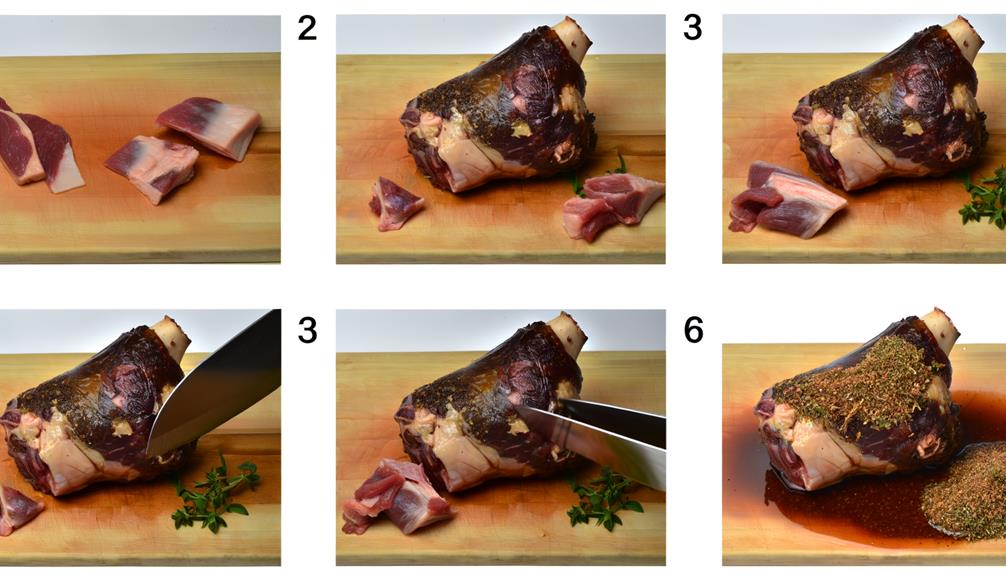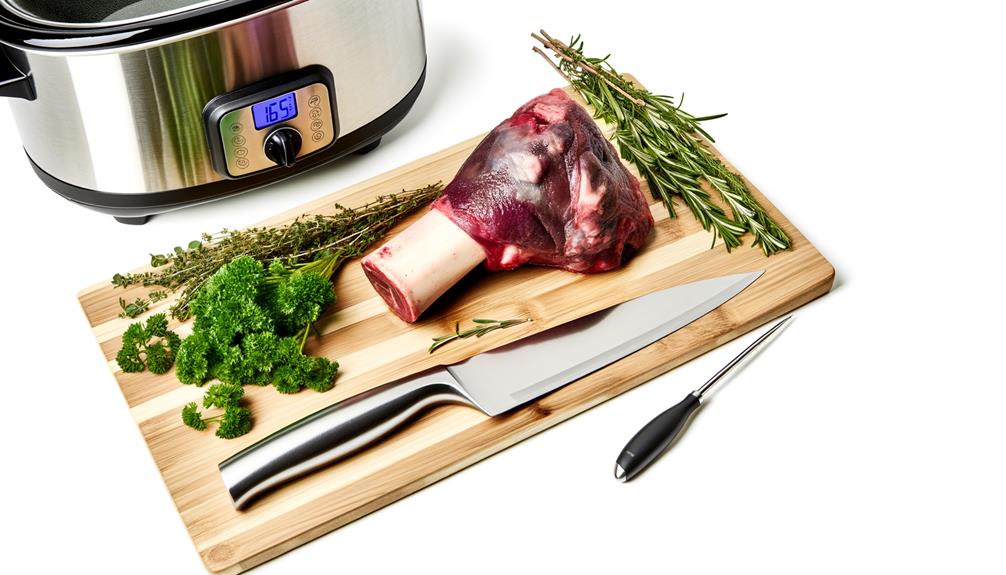To cook beef shank, first trim any excess fat. Then, season it generously with salt and pepper. Sear the shank on all sides in a hot pan with olive oil. This locks in the flavors. Next, slow cook it in a preheated oven. This makes it tender and brings out its rich taste. For the best results, you should aim to cook it for around 4-6 hours. Choosing a high-quality, bone-in shank from a reputable butcher can also enhance the flavor. Stick around to discover more tips that'll help you whip up a flavorful and satisfying beef shank dish.
Beef Shank's Historical Use
Diving into the history of beef shank, you'll find this rich, nutrient-dense cut has been a treasured staple in traditional dishes like Osso Bucco and hearty stews, widely used by ancient civilizations and indigenous tribes for its robust flavor. These cultures recognized the value of beef shank, tapping into its rich flavor and nutrient density to create meals that weren't only delicious but also sustaining.
Beef shank was often slow-cooked, a method that brought out its full flavor and guaranteed the meat was tender and juicy. This slow-cooking tradition is still embraced today, especially in dishes like Osso Bucco and stews that have stood the test of time.
Historical cookbooks and culinary texts bear witness to the importance of beef shank in the culinary world. It was, and still is, a staple ingredient in many recipes, showcasing its versatility and nutritional value. And it's not just in professional kitchens where beef shank shines. Traditional family recipes, passed down through generations, often feature beef shank as a key component, further solidifying its status as a beloved ingredient in our kitchens and on our dining tables.
Essential Ingredients for Beef Shank
When it comes to cooking beef shank, you'll need a handful of essential ingredients to bring out the best in this tough yet flavorful cut of meat. To start, I always use bone-in beef shank. It's a bit tougher, but the bone adds incredible flavor during slow cooking.
For seasoning, nothing beats the classic combination of salt and pepper. They enhance the natural taste of the beef shank without overpowering it. Then, to brown the meat, a drizzle of olive oil works wonders. It also adds a subtle richness that complements the beef beautifully.
To tenderize the beef shank and infuse it with even more flavor, I recommend using a good quality wine or broth. It's a game changer, trust me. Here's a simple table summarizing the main ingredients and their roles:
| Ingredient | Role |
|---|---|
| Bone-in beef shank | Adds flavor |
| Salt and pepper | Enhances taste |
| Olive oil | Aids in browning and adds richness |
| Wine/Broth | Tenderizes and infuses flavor |
Beef Shank Preparation Guide

Now that we've got our ingredients sorted out, let's walk through the steps to prepare your beef shanks for cooking. These budget-friendly cuts of meat are affordable and packed full of flavor, but they do require some special treatment to get them ready for the oven.
Here's a quick beef shank preparation guide:
- First, trim any excess fat from your beef shanks. They've got enough flavor on their own, and you don't need the extra greasiness.
- Next, season your shanks generously. Salt, pepper, and your favorite spices will do. Remember, this is a big, sturdy cut of meat and it can handle a lot of flavor.
- Then, you'll want to braise your beef shanks. This means searing them quickly on all sides in a hot pan. It's a great way to lock in flavor before slow cooking.
- Now, it's time for slow cooking. Pop your shanks into a preheated oven and let them do their thing.
- Finally, after a few hours, you'll have tender, flavorful beef shanks ready to serve.
With a little preparation, these affordable cuts can turn into a tender, flavorful meal that's sure to impress.
Expert Tips
Let's move on to some expert tips for cooking beef shank.
We'll first talk about how to pick the best quality cuts for your dish.
Next, we'll cover different cooking techniques.
Choosing Quality Beef Shank
Selecting a quality beef shank isn't as daunting as it may seem, you just need to know what to look for. First, the color should be bright red, indicating freshness. Avoid any beef shank that looks slimy or has a strong odor. The texture should be firm, not soft. Look for marbling – those white streaks of fat within the meat. It's crucial for tenderness and flavor.
It's also important to contemplate where your beef shank comes from. I recommend grass-fed or pasture-raised beef shank as they often have superior taste and nutritional benefits. Quality butcher shops or reputable farms are ideal places to source it. Remember, the quality of your beef shank will greatly influence your final dish.
Cooking Techniques Overview
While beef shank might seem tough to tackle, with the right cooking techniques, it can be transformed into a tender, richly flavored dish that provides three edible parts: meat, bone marrow, and gelatin. Cooking Beef Shanks requires patience, as it involves slow cooking for 4 to 6 hours to achieve the desired tenderness.
Braising is a fantastic method to use, where you cook the beef shank in moist heat, typically a mixture of beef broth and water. This cooking process is essential for breaking down the tough connective tissues and extracting the maximum flavor profile from the shank. Remember, the aim is to end up with a dish that's packed with flavor and has a tender texture that melts in your mouth.
Perfecting Beef Shank Recipe
Now that we've explored the key techniques for cooking beef shank, I'm going to share some expert tips on perfecting your beef shank recipe.
Embrace slow cooking or braising for achieving ideal tenderness. These methods require long cooking times, but the results are worth it.
Remember, beef shank shines in soups and stews, where the heat can work its magic. Aim for a cooking time of around 4-6 hours. This will allow the beef shank's rich flavor to fully develop.
It's a hearty cut of meat, so use it in dishes that can stand up to its robust taste. With patience and the right technique, you'll craft a beef shank dish that's brimming with flavor and tenderness.
Final Thoughts
In conclusion, I've found that despite its toughness, beef shank's rich flavor and nutritional value, combined with the right cooking techniques, make it a rewarding choice for a variety of hearty meals. Beef shanks, when boiled or slow cooked, can transform from a tough cut to a tender, flavorful dish. It's all about patience and technique. Slow cooking or braising them for hours allows the fibers to break down and become tender.
Moreover, the intense flavor of beef shanks can greatly enhance the taste of soups and stews. The marrow in the bone, released during the slow cooking process, enriches the dish, making it even more delicious and nutritious.
